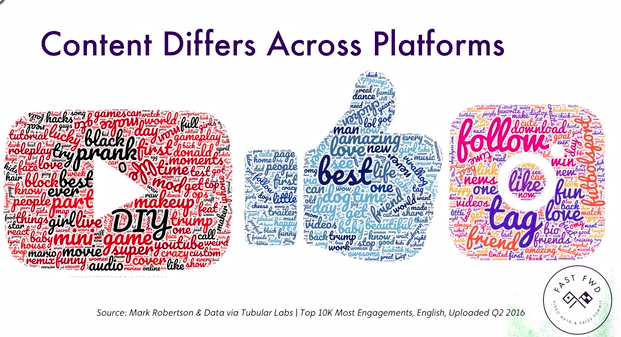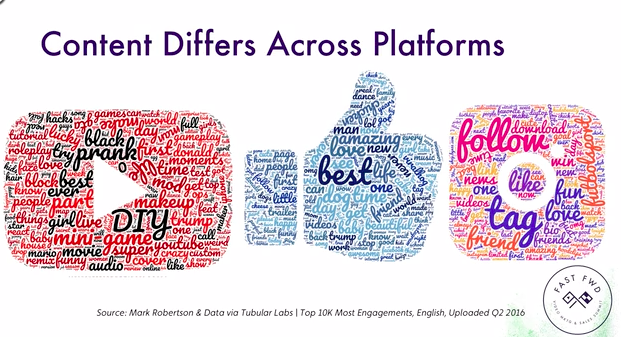3 Things You Need to Know to Dominate Video On YouTube, Facebook, and Instagram. The same goes for video (or any content, for that matter) across different social platforms. Take Facebook and YouTube for example: YouTube is mature and diverse YouTube is a video-first destination with a focus on maximizing video consumption, whereas Facebook is social first and focuses on ease of sharing YouTube has a big focus on search, whereas Facebook does not YouTube has both short and long-form content, whereas Facebook has mainly short-form Mark Robertson, Co-founder of Little Monster Media Co., recently shared the 7 Rules for Optimizing B2B Video on YouTube and Social. Content Discovery One of the biggest differences across platforms is the way content is consumed. To be watched, a video on Facebook must catch the consumer’s eye as they’re scrolling through their feed. Of course, for an optimal video on Instagram, it’ll be a 1:1 aspect ratio. Here’s a full breakdown of recommended technical requirements for video on each platform according to their user guidelines: Caption length text: Text only, max 2,200 characters Recommended Aspect Ratio: 1.77:1 / 16:9 / HDTV, 2:39:1 or 2:40:1 / Widescreen / 9:16, 1:1 / 1.33:1 / 4:3 / SDTV, 1.375:1 / film, 1.85:1 / Film, no pillar boxing or letter boxing Length: 120 minutes max Minimum resolution: minimum width 600 pixels, length dependent on video aspect ratio File Size: Up to 4GB max Frames: 30fps max Format: Full list of supported file formats here Bitrate: No limit to bitrate file if you’re using two pass encoding, as long as long as your file doesn’t exceed 1 GB. Your image should include minimal text. YouTube uses 16:9 aspect ratio players. Discover the 7 Rules for Social Video Watch the full version of Mark’s talk, 7 Rules for Optimizing B2B Video on YouTube and Social, to also see: Channel and profile page best practices for optimizing for video Advertising guidelines for YouTube and Facebook Recommendations for meta descriptions, tagging, etc How to maximize engagement with the text surrounding your video And more!
Would you write the same birthday card to your Grandma May on her 80th birthday as to your nephew Sal on his 8th birthday? I would bet not. Why? Because they have different tastes and are looking for different things. Sure, they’re both birthday cards but you can’t just reuse the same card for a different purpose.
The same goes for video (or any content, for that matter) across different social platforms. Since content consumers go to different social platforms for different reasons, it’s important to understand so that you can tailor your video content accordingly.
Take Facebook and YouTube for example:
- YouTube is mature and diverse
- YouTube is a video-first destination with a focus on maximizing video consumption, whereas Facebook is social first and focuses on ease of sharing
- YouTube has a big focus on search, whereas Facebook does not
- YouTube has both short and long-form content, whereas Facebook has mainly short-form
Mark Robertson, Co-founder of Little Monster Media Co., recently shared the 7 Rules for Optimizing B2B Video on YouTube and Social. This is a quick recap of some of the top lessons from his talk with three key ways to maximize the impact of your video content across different platforms. If you want to watch Mark’s full, 29 minute session, you can check it out here.
1. Content Discovery
One of the biggest differences across platforms is the way content is consumed. Mark defines the difference as a “push” and “pull” experience.
Social platforms like Facebook and LinkedIn rely on the discovery through a “push” experience or mainly organic, passive discovery. To be watched, a video on Facebook must catch the consumer’s eye as they’re scrolling through their feed.
YouTube, on the other hand, has a “pull” experience where consumers of content have to know what they’re looking for in order to find it.
As Mark says, “On Facebook, your mission is to stop someone scrolling past your video in their newsfeed and grab their attention immediately.” And, in fact, 65% of people who watch the first three seconds of a video will watch more than 10 seconds on Facebook.
We can see the difference in content across different platforms even just from the meta tags used. That’s exactly what’s represented in the word clouds below:

- YouTube is mainly descriptive, but definitely diverse
- Facebook is emotional, inspirational, and provocative (think about the reaction buttons on Facebook)
- Instagram is fun, happy, and about building a community
Learn more about the patterns of content discovery on each platform from Mark’s talk.
2. Getting Traffic Back to Your Website
I’m going to go out…

COMMENTS